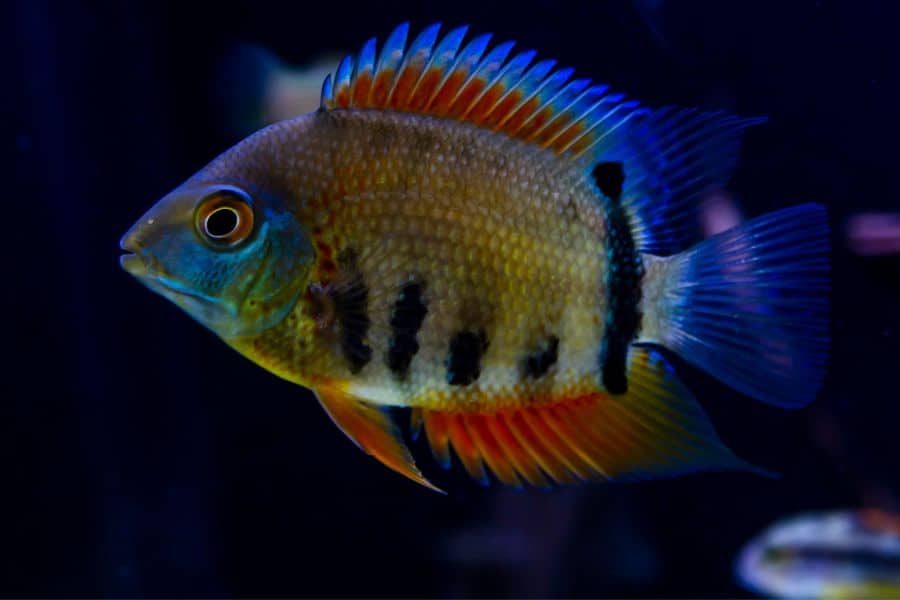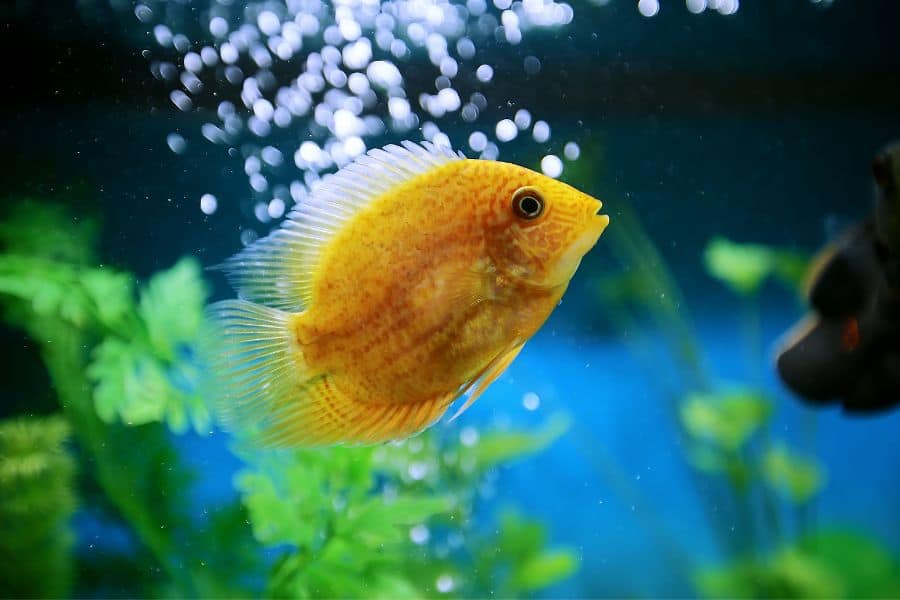Severum Cichlids can live up to 10 years if you properly care for them. These hardy fish are some of the hardiest fish on the market, and they are beloved for their magnificent colors spanning from bright golds to mesmerizing blues, reds, and greens.
The low-maintenance species is known for its peaceful nature that makes coexistence easy, as well as its beauty that tends to get more enticing as it ages.
The severum cichlid is the fish for you if you are new to the business and want a beautiful fish that is easy to maintain and can peacefully live with lots of aquarium fish.
Read on to learn all the important facts about the severum cichlids. Get to know their origin and physical characteristics. All you need to know to carefully and successfully care for the gorgeous species is outlined in detail below.
Severum cichlids Overview
Short Summary of Severum Cichlids and their habitats:
| Names | Severum Cichlids (Heros severus)
Also known as the banded cichlid, or poor man’s discus |
| Origins and Reginal Distribution | Originated from South America, particularly the Amazon Basin and parts of Northern Peru |
| Tank Size | 45 Gallons Minimum
More than 100 gallons for adults and breeding purposes |
| Water Hardness Conditions | 4.0 – 15.0 dGH |
| Ideal Tank Mates | Angelfish, Blood Parrot Cichlid, Black Skirt Tetra, Hoplo Catfish, Gouramis, Convict Cichlids, Tiger Barb, African butterflyfish |
| Average Size | 8 – 12 inches |
| Colors | Green-Gold color morphs are more prevalent, but others exist, like blue, white, red spotted, and yellow |
| Lifespan | Typically, 5 years, but can live up to 10 years in the most ideal environment |
| Diet | Omnivorous diet |
| Breeding | Hardy Water Surfaces |
| Optimal pH levels | 6.0 – 7.5 |
| Optimal Temperature | 75 – 85 degrees Fahrenheit |
The Heros severus is the scientific name for the severum cichlids. However, the aquarium trade also classifies the Heros efasciatus in the same category due to their similar appearances & traits.
Technically, the golden/gold-green/yellow-gold/banded severum is the Heros severus while Heros efasciatus consists of the red-spotted, red shoulder, blue, and turquoise severum.
Fish traders also tend to refer to all genus Heros fish as severum cichlids. This means that the Heros liberifer, Heros spurius, Heros notatus, Heros severus, and Heros efasciatus are part of the severum cichlid tree.
Severum Cichlid Lifespan, Size, Appearance, Breeding & More
Lifespan
Proper care is the main determiner of the severum cichlid’s lifespan. A typical fish of this species will live up to 5 years, provided you stick to the recommended guides. However, it is not uncommon to find a severum that is over 5 years, maybe 10 years old.
This often happens in the wild where conditions are optimal or in an ideal tank with a great environment, diet, and tank mates. To extend the lifespan of the severum cichlids; ensure you place them in the tank that is not prevalent to diseases, stick to a nutritious diet & feeding schedule, keep water and tank quality optimal at all times, and reduce any stress the fish may face.
Appearance: Types, Shape, Colors & Size
One thing that can pose a challenge to first-timers is the severum’s size. These fish can grow up to 12 inches but typically are about 8 – 10 inches. This is a challenge, especially when you are keeping a community of them.
You may need to upgrade your tank over time or purchase a bigger one, to begin with. It also means that the bio load is more and that you will need more food to feed them.
When it comes to color, the most common severum is the base green cichlid with goldish stripes. The colors can be quite confusing, considering how many variations of the species exist. However, they are all based on one base color covered by dark-colored stripes that stretch throughout the fish’s body.
The color types include:
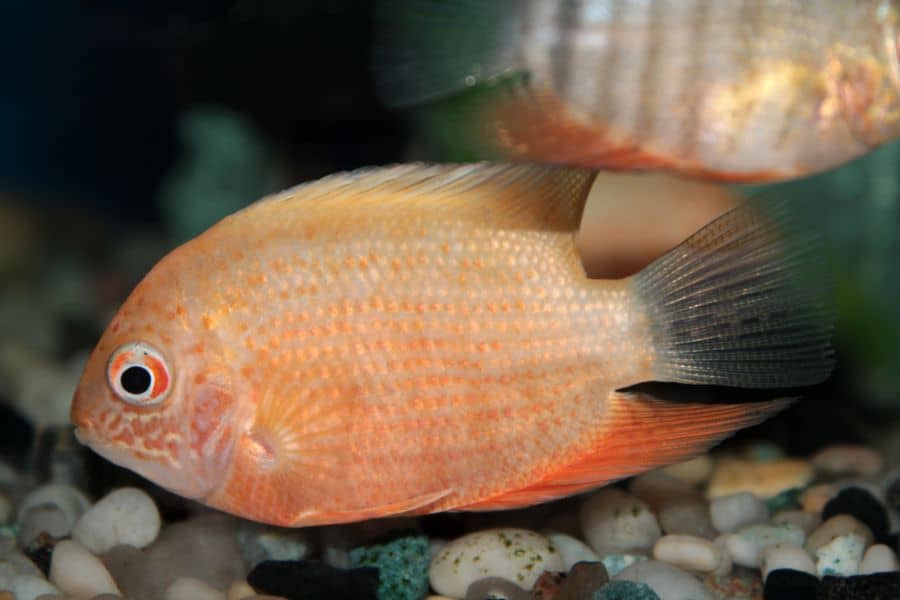
- Red-Spotted Severum – gold with red spots down its entire length
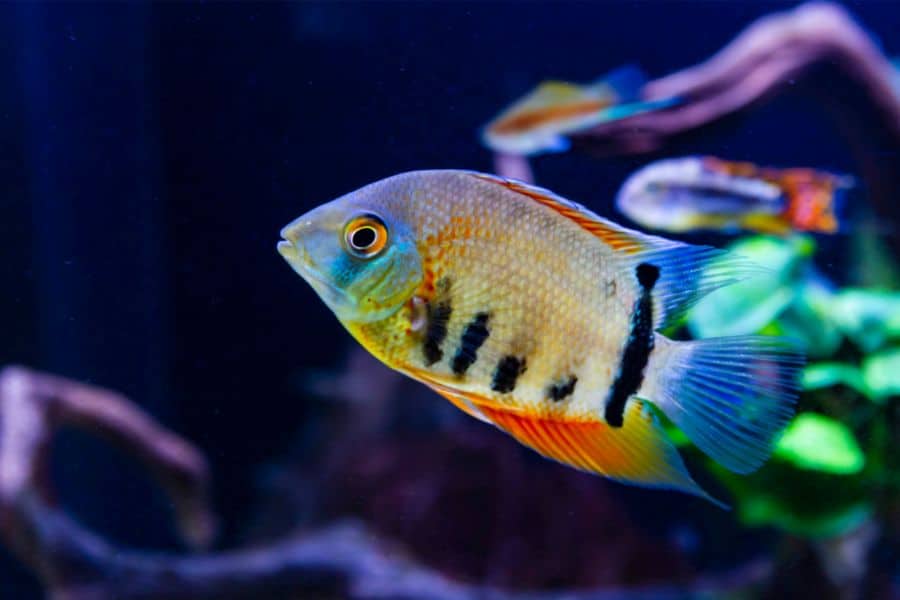
- Red Shoulder/ Rotkeil/Necktie Severum – featuring red colored shoulders and native to Northern Peru
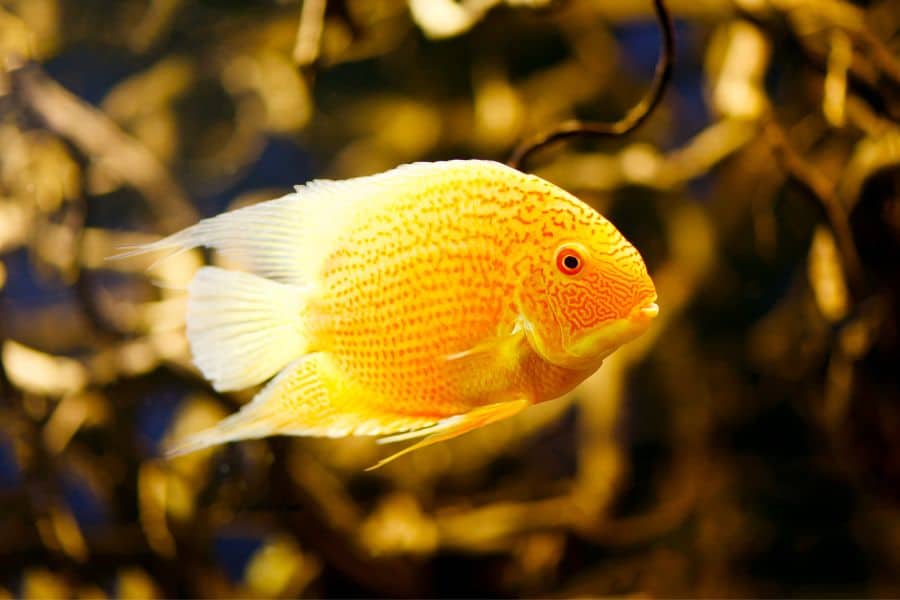
- Golden Severum – gold with dark stripes, it is the main species that has given rise to other colors, including the red-spotted severum
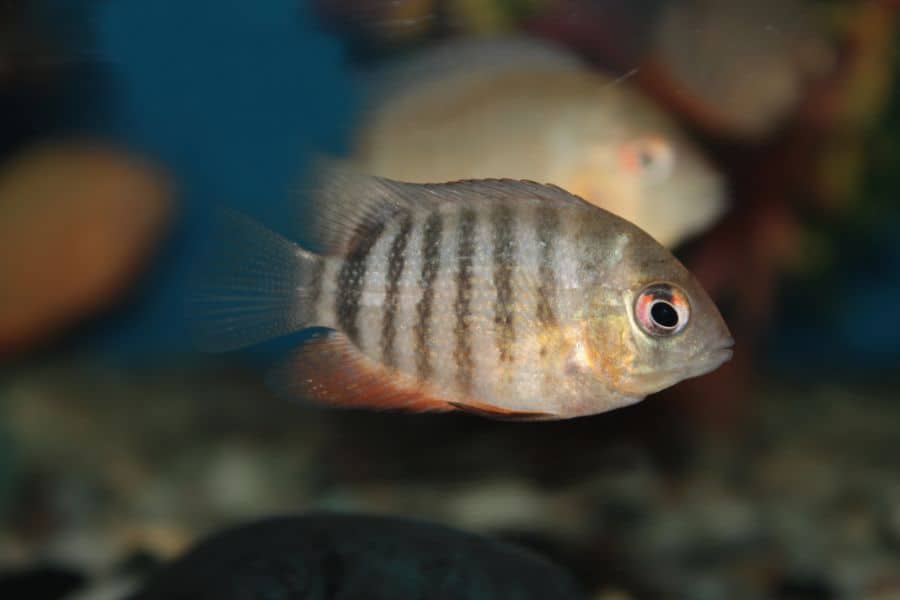
- Turquoise Severum – yellow base color with dark stripes
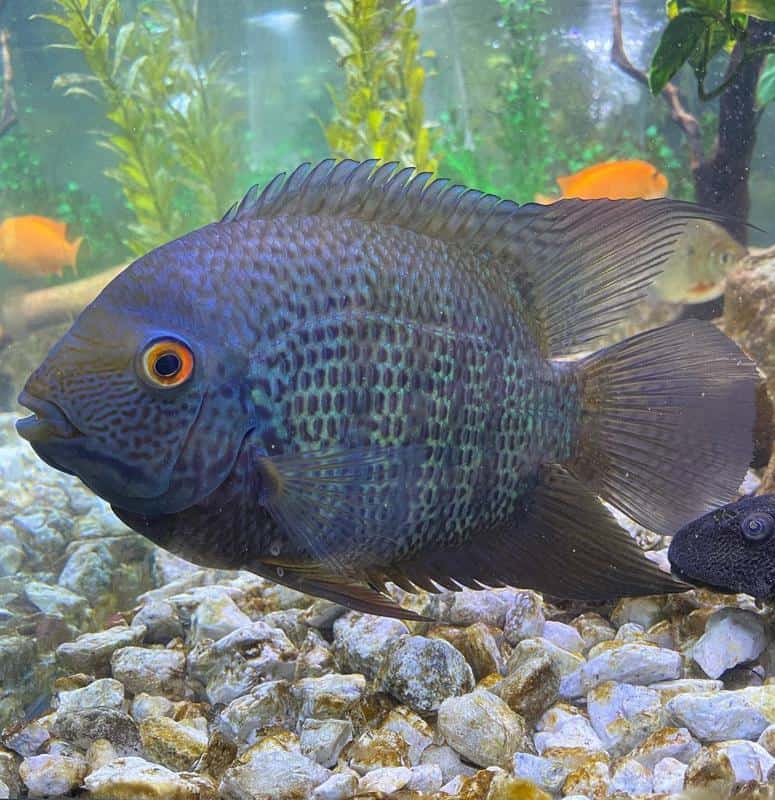
- Green Severum – green with brown stripes running down its body
- Blue Severum – native to Amazon Basin and features a blue base color with dark stripes
- White Severum – this type is all white with no stripes at all
Regardless of the colors, these cichlids tend to become more attractive as they age because the colors become more intense and vibrant. Another common aspect is their yellow eyes and pointed pectoral, dorsal, and anal fins.
Severums are also differentiated by their thin oval bodies that look compressed, featuring a round shape on the vertical side.
Behaviors
So, are green Severums aggressive? Well, it depends on the situation. Severum cichlids are a peaceful species in most cases and tend not to disturb other tank mates if they are compatible. However, the cichlids get aggressive during the breeding period, where they have to protect their eggs, the females, and the young juveniles.
The severums have no problem living in solitude, but you will much prefer to keep them in pairs because otherwise, they will not breed.
Severum cichlids are active explorers and eaters. They have a high appetite that requires you to feed them at least twice every day; four times is recommended. They search for food endlessly during the day, and you will find them eating water plants that can fit their diet.
You will also find them digging through the sandy substrate, making incredible hills and valleys that they later come and reshape. They are a fun bunch that can entertain you all day.
Severum Cichlid Care Guide
The Severum is a hardy fish. With a lifespan of up to 10 years, you can expect the species to survive in a multitude of water conditions.
Despite their hardiness, it is always important to keep up with the ideal water and tank conditions to ensure the species thrives and breeds with ease. Most of your ideal conditions will depend on whether you want to breed the severums or not.
Tank Size & Environment
Severums are best kept in tanks that are more than 45 gallons. The bigger the tank, the better. One severum can thrive in solitude in a 45-gallon tank, but when you want to raise a whole community, it is recommended you opt for a tank that is at least 100 gallons.
A fine sandy substrate is a must since the fish dig into the sand to make hills and pits as they move. It is a beautiful marvel when you see the intricate shapes that come about as a result of their hunts and playful nature.
Please consider adding more vegetation and décor to ensure the fishes have more places to dig into and explore. It helps reduce stress and enriches the tank’s vastness when you have a community of cichlids.
Flat rocky surfaces are a great addition to a breeding tank. The severums prefer to lay their eggs on flat rocky surfaces where they can hatch. This may not be so important if you have a separate tank for breeding purposes.
Last but not least, the filtration and maintenance system is more crucial when raising a community. The bio load is more in this case, and you will need all the tank maintenance crew you can get to ensure optimal conditions are always kept.
What fish can live with Severum cichlids?
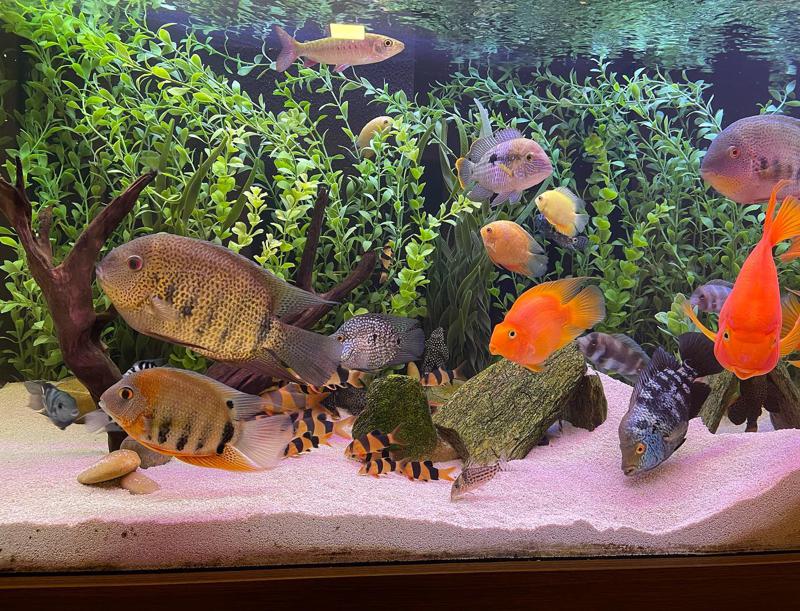
Before you choose the ideal severum tank mates, ensure they are able to survive in the same water parameters as the severums. And since the severum cichlids are a peaceful less-aggressive species, it would be best you pair them with equal temperament fishes.
Avoid aggressive species that can stress the cichlids or are big enough to eat the cichlids. Despite their peaceful nature, severum cichlids can feed on smaller peaceful tank mates. Do not put any species with cichlids if they can end up as their dinner when they are starving.
Suitable tank mates include:
- Angelfish
- Blood Parrot Cichlid
- Redtail black shark
- Black Skirt Tetra
- Hoplo Catfish
- Gouramis like the dwarf gourami and the moonlight gourami
- Jack Dempsey fish
- Convict Cichlids
- Silver Dollar Fish
- Tiger Barb
- African butterflyfish
- Oscar Fish
- Green terror cichlid
Related: Best Cichlid Tank Mates
So, should severums be kept in pairs? For breeding, yes, you should keep them in pairs. You cannot successfully breed severums without them pairing up.
However, you do not have to keep the severums in pairs if you just want to have a decorative, fun fish in your aquarium.
Water Quality and Water Parameters
The hardiness of the severum cichlids makes it a great addition to a tank that only gets a little maintenance, to begin with. It is not a reason not to keep up with your maintenance, but it shows you will require less work to keep the cichlids alive and thriving.
Severum cichlids can survive in brackish waters on typical days, even during the breeding season. They also do not require water waves; moderate water movement is more than adequate for them.
Like other aquatic life, you do not want to have any toxic substances in the water. That means you should keep the ammonia, nitrate, and nitrite levels at zero.
Temperature is an important aspect since these cichlids require different hotness degrees when they are breeding. Keep the temperatures higher during the breeding period; this will not affect the lives of the non-breeding cichlids in the tank but will make it more likely that the breeding bunch gives rise to thousands of eggs.
- Water Temperature: 75 – 85 degrees Fahrenheit for typical days, 80 – 85 degrees Fahrenheit for the breeding season
- pH level: 0 – 7.5, Below 6.0 for the breeding season
- Water hardness: 4 – 15 dGH
- Lighting: Dim lighting
- Ammonia, nitrate, nitrite levels: 0 PPM
Breeding
The great thing about this species is that it is very easy to differentiate the females from the males. Female severums have a unique dark spot on their dorsal fin that is not present on the male severums.
Males, on the other hand, typically have a nuchal hump on their dorsal fins, making the fins more pointed than the female severums. Male severums can also be differentiated from the female species with their larger size and marked gills.
These cichlids will breed more effectively if you use juvenile cichlids instead of adult ones. This is because the severum cichlids breed by naturally pairing up, ensuring that the adult cichlids are able to take care of the young ones.
The first thing to remember about the breeding style of severum cichlids is that the fish get more aggressive during this period to protect their young ones. Having the breeding pair in a separate tank can ensure you have more juveniles and less aggression in the tank.
As the juveniles grow together, they pair up naturally and create a bond fit for breeding at any time. The fish start breeding as soon as they pair up. Severum cichlids reproduce by spawning.
At this point, the male’s color would have intensified and gotten darker to show its ready to mate. The male then goes after the female, catches up with her, and engages in breeding practices like lip-locking and tail-slapping. The pair proceed to look for flat rocky surfaces in the water tank.
The female then lays eggs on the flat rocky surfaces as the male proceeds to fertilize the eggs by releasing sperm. This is the spawning stage.
The eggs take between three to five days to hatch. During this period, the male is very aggressive. It takes charge of defending both the mother and the eggs aggressively.
However, it is also important to note that younger severum cichlids have a bad tendency to eat the eggs. Many experienced breeders opt to scoop the eggs and place them in a separate aquarium where they can be raised. This is the way to go if you want a bigger stock.
Many severums will be good parents, and you will only have to feed the hatched younglings with highly nutritious baby food like micro worms and brine shrimp. Please ensure the food is easy for the small fish to eat in a few minutes and get it through their tiny mouths.
The parents will look out for the young ones till they are mature enough to venture out on their own: this is typically done in under 6 weeks. Juvenile fish grow slower compared to most fish species. It takes up to two years for the young severum cichlid to reach its peak size. Below are a few considerations to ensure successful breeding:
- Temperature: 80 – 85 degrees Fahrenheit
- Diet: High Protein Diet
- Water pH levels: More acidic (Below 6.0) to help eggs mature
- Water Hardness: 2 – 6 degrees of hardness
- Water Surface: Flat rocky surface for spawning
Severum Cichlid Diet
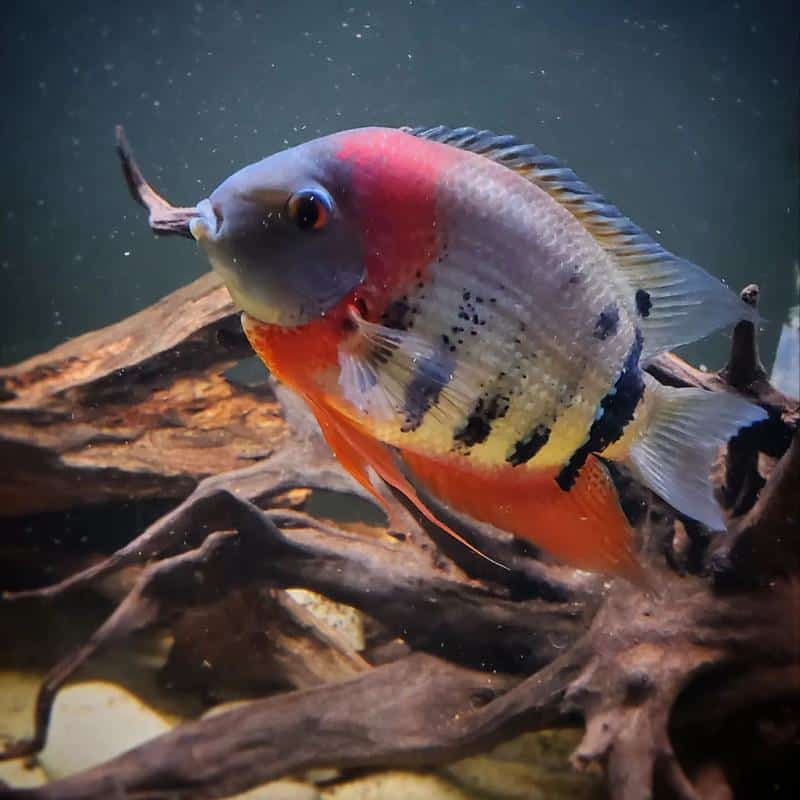
The severum cichlid diet is omnivorous.
Their diet is any hobbyist’s preference since they can eat a wide range of fish foods from vegetables to worms to flakes, pellets, and other aquatic fish.
Favorite greens include cucumber and zucchini. Freeze-dried worms are also a great meal for these omnivores since they are rich in vitamins and proteins. Other vitamin-rich foods for severums include earthworms, crickets, and brine shrimps.
Despite their diet, severum cichlids are known often feed on meaty foods from aquatic insects to shrimps, aquatic animal eggs, smaller snails, and worms. The red-spotted severums are known for feeding on smaller fish like the tetras.
Other severums prefer veggie diet like lettuce and peas. Put edible water plants to keep their veggie diet rich. The Canadian water weed and Brazilian elodea are some of the water plants that the severums love to eat.
Like other fish, you do not want to overfeed the severums. They are okay with eating twice to four times per day. Anything more than that will contribute to tank waste and toxicity, affecting water parameters and quality.
Keep the meals in smaller portions that can be consumed in less than five minutes. This will ensure you only provide the fish with the right amount of food they can eat at any given time.
Read More:
Summing Up
Severum cichlids are hardy freshwater fish that are less aggressive than other cichlid species. This makes them a great addition to a typical aquarium tank, especially for beginner hobbyists and enthusiasts.
The most important aspects for a thriving severum cichlid colony are to have a bigger tank, about 100 gallons, and ensure you create the right environment for breeding.
You will also want to look out for common illnesses like Ich, the white spot disease, which is easily cured when diagnosed early.
